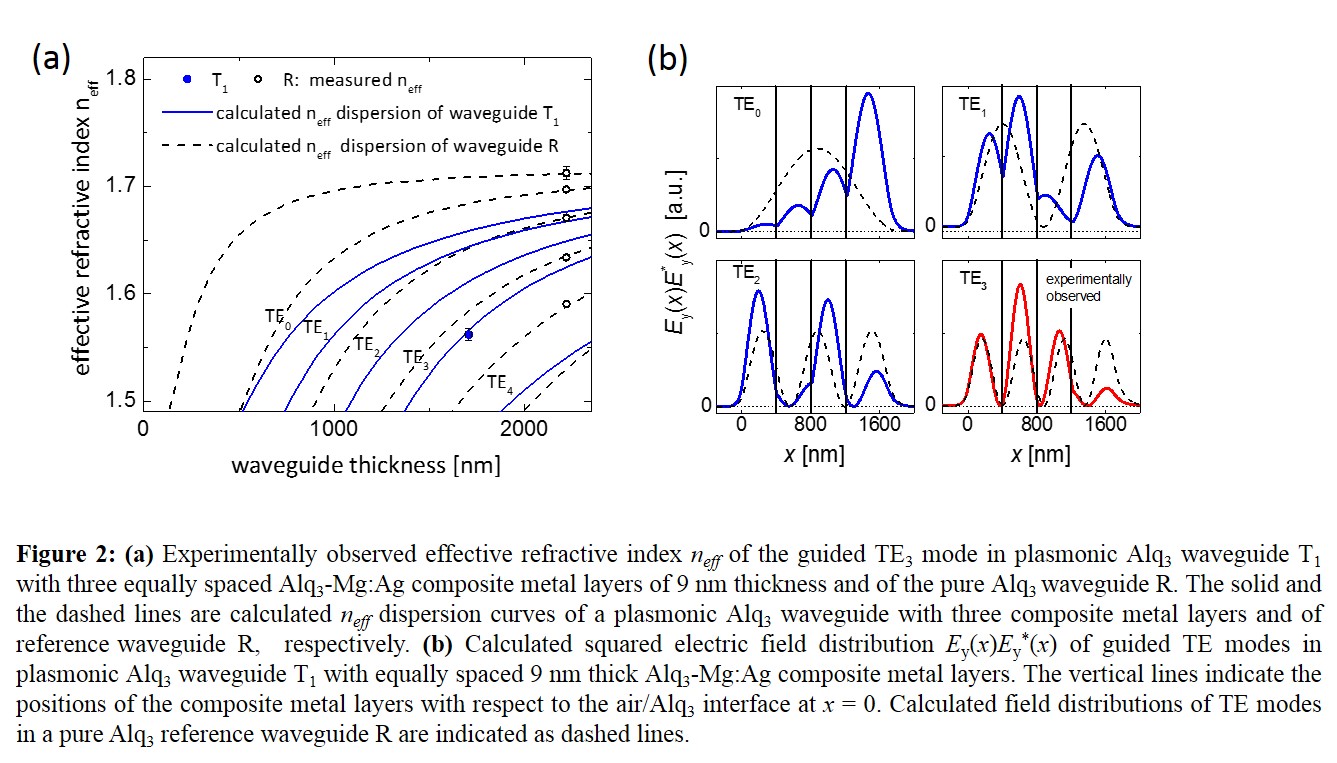Organic Multilayers and Metal/Organic Waveguides
We investigated the mode properties of long-range surface plasmon polaritons (LRSPP) in planar dielectric aluminum-quinoline (Alq3) multilayer waveguides comprising one single or three equally spaced embedded nanometer-thin (~10 nm thick) Alq3-Mg0.9:Ag0.1 composite metal-island layers 1. The plasmonic waveguides were fabricated by OMBD. Transverse magnetic (TM) and transverse electric (TE) modes were selectively excited using the m-line method. The symmetric plasmonic TM0 mode was launched in all waveguides and -in addition- two higher order plasmonic TM1 and TM2 modes were generated in waveguides comprising three metal layers (see Fig. 11). TM modes which have their antinode(s) in the dielectric layers propagate essentially like dielectric modes. Transverse electric (TE) modes with antinode(s) at the position of the metal layer(s) are strongly damped while the losses are low for TE modes comprising a node at the position of the composite metal film(s) (see Fig. 21) . The possibility to control the effective refractive index and the losses for individual hybrid plasmonic-dielectric TM and dielectric TE modes opens new design opportunities for mode selective waveguiding and TM-TE mode coupling.


1Reprinted with permission from N. Wickremasinghe, J. Thompson, X. Wang, H. Schmitzer and H. P. Wagner,Controlling guided modes in plasmonic metal dielectric multilayer waveguides, J. Appl. Phys. 117, 213102 (2015), Copyright 2015, AIP Publishing LLC.
Index matching in multilayered organic waveguides
Index matching of guided modes in birefringent multilayered organic waveguides opens new prospects for the design of mode coupling and mode switching devices. We demonstrate index matching of guided modes in two multilayered structures, in (a) a PTCDA-Alq3-PTCDA three-layer (see Fig. 3 1) and (b) a PTCDA-Alq3 effective medium multilayer waveguide (see Fig. 4 2). The optical waveguides were grown on a Pyrex substrate by organic molecular beam deposition (OMBD). The occurrence of index matching was investigated both experimentally by measuring the effective refractive index dispersion of transverse electric (TE) and magnetic (TM) modes using the m-line technique and theoretically by modelling the index dispersion with a transfer matrix algorithm. Our experimental and theoretical investigations open new prospects for the design of mode filtering and switching devices including electro-optical or magnetic TE-TM mode converters.


2Reprinted with permission from J. Thompson, F. Albalawi, N. Wickremasinghe, G. Salvan, D. R. T. Zahn, H. Schmitzer and H. P. Wagner, Index matching in multilayered organic waveguides, J. Phys.: Condens. Matter 32, 485702 (2020), Copyright 2020, IOP Publishing Ltd.
